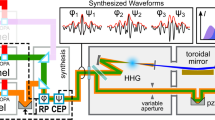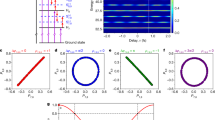Abstract
The attosecond lighthouse is a method of using ultrafast wavefront rotation with high-harmonic generation to create a series of coherent, spatially separated attosecond pulses. Previously, temporal measurements by photoelectron streaking characterized isolated attosecond pulses created by manipulating the single-atom response1,2,3,4. The attosecond lighthouse, in contrast, generates a series of pulses that spatially separate and become isolated by propagation. Here, we show that ultrafast wavefront rotation maintains the single-atom response (in terms of temporal character) of an isolated attosecond pulse over two octaves of bandwidth. Moreover, we exploit the unique property of the attosecond lighthouse—the generation of several isolated pulses—to measure the three most intense pulses. These pulses each have a unique spectrum and spectral phase.
This is a preview of subscription content, access via your institution
Access options
Subscribe to this journal
Receive 12 print issues and online access
$209.00 per year
only $17.42 per issue
Buy this article
- Purchase on Springer Link
- Instant access to full article PDF
Prices may be subject to local taxes which are calculated during checkout




Similar content being viewed by others
References
Sansone, G. et al. Isolated single-cycle attosecond pulses. Science 314, 443–446 (2006).
Goulielmakis, E. et al. Single-cycle nonlinear optics. Science 320, 1614–1617 (2008).
Feng, X. et al. Generation of isolated attosecond pulses with 20 to 28 femtosecond lasers. Phys. Rev. Lett. 103, 183901 (2009).
Ferrari, F. et al. High-energy isolated attosecond pulses generated by above-saturation few-cycle fields. Nature Photon. 4, 875–879 (2010).
Brabec, T. & Krausz, F. Intense few-cycle laser fields: frontiers of nonlinear optics. Rev. Mod. Phys. 72, 545–591 (2000).
Corkum, P. B. Plasma perspective on strong-field multiphoton ionization. Phys. Rev. Lett. 71, 1994–1997 (1993).
Corkum, P. B., Brunett, N. H. & Ivanov, M. Y. Subfemtosecond pulses. Opt. Lett. 19, 1870–1872 (1994).
Paul, P. M. et al. Observation of a train of attosecond pulses from high harmonic generation. Science 292, 1689–1692 (2001).
Mairesse, Y. et al. Attosecond synchronization of high-harmonic soft X-rays. Science 302, 1540–1543 (2003).
Krausz, F. & Ivanov, M. Attosecond physics. Rev. Mod. Phys. 81, 163–234 (2009).
Vincenti, H. & Quéré, F. Attosecond lighthouse: how to use spatiotemporally coupled light fields to generate isolated attosecond pulses. Phys. Rev. Lett. 108, 113904 (2012).
Kim, K. T. et al. Photonic streaking of attosecond pulse trains. Nature Photon. 7, 651–656 (2013).
Wheeler, J. A. et al. Attosecond lighthouses from plasma mirrors. Nature Photon. 6, 829–833 (2012).
Kim, K. T., Kim, C. M., Baik, M.-G., Umesh, G. & Nam, C. H. Single sub-50-attosecond pulse generation from chirp-compensated harmonic radiation using material dispersion. Phys. Rev. A 69, 051805 (2004).
López-Martens, R. et al. Amplitude and phase control of attosecond light pulses. Phys. Rev. Lett. 94, 033001 (2005).
Zhao, K. et al. Tailoring a 67 attosecond pulse through advantageous phase-mismatch. Opt. Lett. 37, 3891–3893 (2012).
Ko, D. H., Kim, K. T. & Nam, C. H. Attosecond-chirp compensation with material dispersion to produce near transform-limited attosecond pulses. J. Phys. B 45, 074015 (2012).
Hofstetter, M. et al. Attosecond dispersion control by extreme ultraviolet multilayer mirrors. Opt. Express 19, 1767–1776 (2011).
Bourassin-Bouchet, C. et al. Shaping of single-cycle sub-50-attosecond pulses with multilayer mirrors. New J. Phys. 14, 023040 (2012).
Naumov, A. Y., Villeneuve, D. M. & Niikura, H. Contribution of multiple electron trajectories to high-harmonic generation in the few-cycle regime. Phys. Rev. A 91, 063421 (2015).
Kane, D. J. Recent progress toward real-time measurement of ultrashort laser pulses. IEEE J. Quant. Electron. 35, 421–431 (1999).
Mairesse, Y. & Quéré, F. Frequency-resolved optical gating for complete reconstruction of attosecond bursts. Phys. Rev. A 71, 011401 (2005).
Chini, M., Wang, H., Khan, S. D., Chen, S. & Chang, Z. Retrieval of satellite pulses of single isolated attosecond pulses. Appl. Phys. Lett. 94, 161112 (2009).
Goulielmakis, E. et al. Real-time observation of valence electron motion. Nature 466, 739–743 (2010).
Mauritsson, J. et al. Attosecond electron spectroscopy using a novel interferometric pump-probe technique. Phys. Rev. Lett. 105, 053001 (2010).
Lefebvre, C. et al. Attosecond pump-probe transition-state spectroscopy of laser-induced molecular dissociative ionization: Adiabatic versus nonadiabatic dressed-state dynamics. Phys. Rev. A 88, 053416 (2013).
Hammond, T. J., Kim, K. T., Zhang, C., Villeneuve, D. M. & Corkum, P. B. Controlling attosecond angular streaking with second harmonic radiation. Opt. Lett. 40, 1768–1770 (2015).
Acknowledgements
We gratefully acknowledge the technical assistance of D. Crane and B. Avery, and useful discussions with A. Naumov. We also acknowledge financial support from Canada's NSERC, NRC, CFI, and CRC, as well as from America's AFOSR and DARPA Pulse Program through a grant from AMRDEC.
Author information
Authors and Affiliations
Contributions
T.J.H., K.T.K. and P.B.C. designed the experiment. T.J.H., G.G.B., and K.T.K. performed the experiment. K.T.K. and T.J.H. provided the theoretical analysis. T.J.H. analysed the experimental data. T.J.H. and P.B.C. prepared the initial manuscript. All authors contributed in writing the manuscript.
Corresponding author
Ethics declarations
Competing interests
The authors declare no competing financial interests.
Supplementary information
Supplementary information
Supplementary information (PDF 1284 kb)
Rights and permissions
About this article
Cite this article
Hammond, T., Brown, G., Kim, K. et al. Attosecond pulses measured from the attosecond lighthouse. Nature Photon 10, 171–175 (2016). https://doi.org/10.1038/nphoton.2015.271
Received:
Accepted:
Published:
Issue Date:
DOI: https://doi.org/10.1038/nphoton.2015.271
This article is cited by
-
Real-time ultrafast oscilloscope with a relativistic electron bunch train
Nature Communications (2021)
-
Strong-field coherent control of isolated attosecond pulse generation
Nature Communications (2021)
-
Attosecond streaking using a rescattered electron in an intense laser field
Scientific Reports (2020)
-
Sub-cycle millijoule-level parametric waveform synthesizer for attosecond science
Nature Photonics (2020)
-
Subcycle dynamics of electron–hole pairs and high-harmonic generation in bulk diamond subjected to intense femtosecond laser pulse
Optical and Quantum Electronics (2018)



